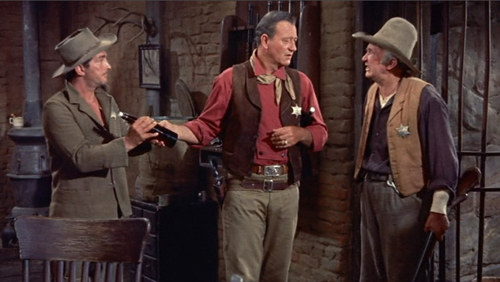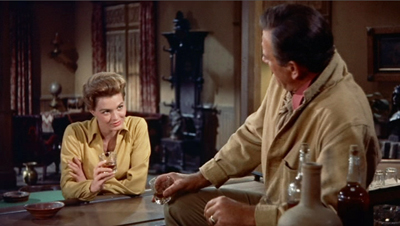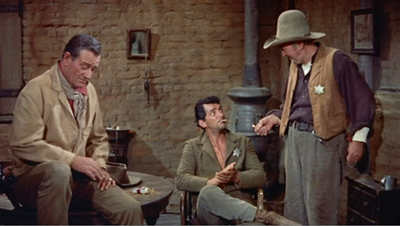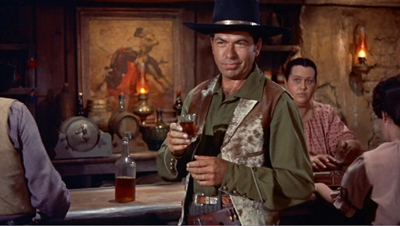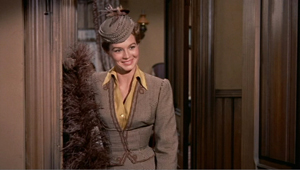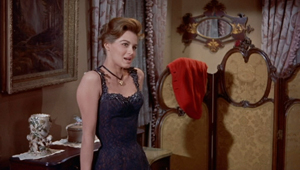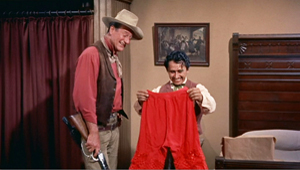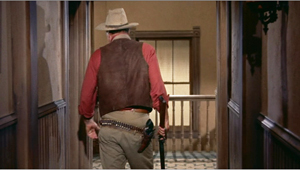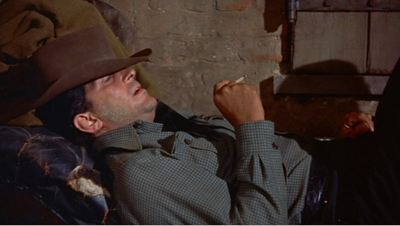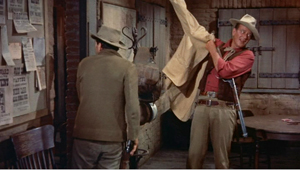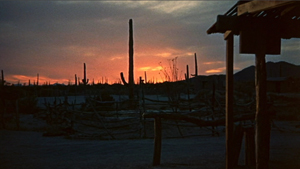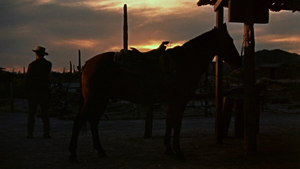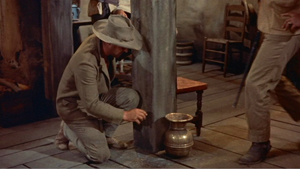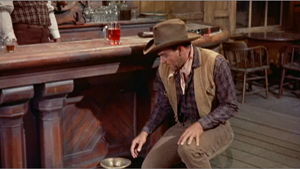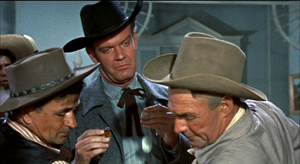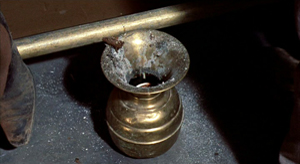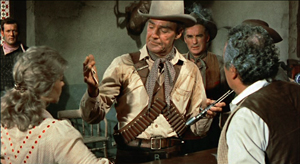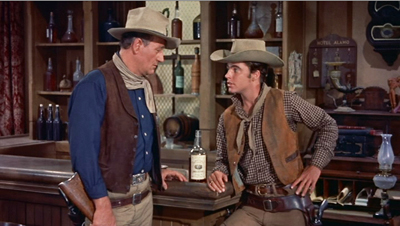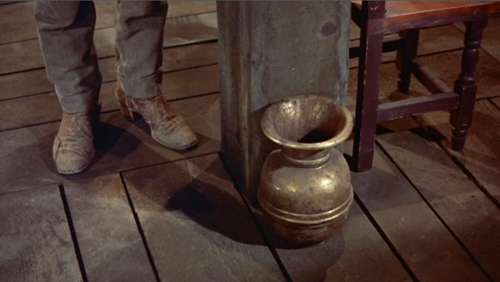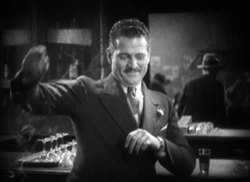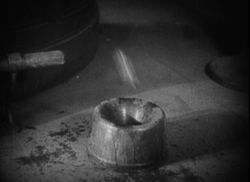The Tao of RIO BRAVO; or, A Yakky Way of Knowledge
Wednesday | April 11, 2012 open printable version
open printable version
Too long has this scrolling site ignored the Sacred Text. In a gesture of penance, I return to the true path. Like all Sacred Texts, this one attracts worshippers in different degrees: the Seekers, the Initiates, the Adepts, and the Exegetes. There are Heretics too. Today, I wish merely to introduce you, who may not yet be even a Seeker, to the serenity of The Way.
The Word, in plenty
Seekers who have become Initiates agree: Their blinding moment of conversion came when they realized that the words of the Sacred Text speak to all times, all places.
Other Sacred Texts dispense a few trinkets of wisdom (“I have a bad feeling about this.” “We’re gonna need a bigger boat.” “Show me the money.”) These are tag lines, sound bites, not poetic glimpses of glory. Uniquely and universally, passages in our Text raise the spirit and cast out doubt and despair. But far from being otherworldly, they carry practical wisdom and illuminate every situation. What crisis in your life, brother or sister, would not be piercingly clarified if you were able to utter one of these lines?
It’s nice to see a smart kid for a change.
I’d say he’s so good he doesn’t feel he has to prove it.
That’s what I’d do if I were the kind of girl you think I am.
Sorry don’t get it done, Dude.
You look a little used.
Aw, I’m not gonna hurt him.
If I’m gonna get shot at, I might as well get paid for it.
Let’s take a turn around the town.
I’m glad we tried it a second time. It’s better when two people do it.
Borachone talking big.
You’d better go easy on that stuff.
Don’t set yourself up as being so special. You’d think you invented the hangover.
Aw, hell, what’s the difference? We’d all be dead by then.
Nobody’s run in here./ We’ll remember you said that.
Found yourself another knot-head who don’t know when he’s well off?
A game-legged old man and a drunk. That’s all you got?/ It’s what I’ve got.
Think you’re good enough?
Is he as good as I used to be?/ It’d be pretty close. I’d hate to have to live on the difference.
To become an Initiate, the Seeker must commit these to memory and meditate upon them intently. An Adept will be able to summon them up, half-consciously, in a range of situations–the more far-fetched, the more enlightening. One will always be appropriate.
The Name
Exegetes have pointed out that the figures of light in the Sacred Text do not have the usual names. They are, emblematically, called Stumpy, Dude (aka Borachone), Colorado, Feathers. He Who Is Called Chance is named John T., but even the middle initial is turned into an epithet (“T for Trouble”).
Far from being an accident, the names in the Sacred Text are there to impel the Initate into deeper mysteries. Is, for instance, Stumpy The Elder called Stumpy because of his lameness—always a sign of grace in sacred texts? Because of his inertness (as stiff as a stump)? Or because a tree, even though harvested, retains its attachment to the earth by remaining rooted? Perhaps He Who Is Called Stumpy is “grounded,” as the current saying has it.
The Text is figural, both metonymic and metaphoric. Young Colorado is son of Rocky Ryan from Denver. He Who Is Called Wheeler is a man of wagons. She Who Is Called Feathers wears feathered clothes, but also has a teasing lightness of manner. He Who Is Called Dude constitutes a crux. Is he a “dude,” an Easterner who has come west, or is he a dude because he favors fancy outfits? (See “Raiment,” below.)
The central fact is that in this text, the mystery of naming opens on to the Mystery of Being. Everyone is named something, but many are not named by their name.
Raiment
Once the devout Seeker has sensed the limitless depths of the The Words, the more inquisitive will turn to the images. In the opening scene of the Sacred Text, a largely wordless series of encounters in barrooms, a world is created before our eyes. It is a world of debasement, treachery, and sudden death. A contemporary text called Variety, secular but still enlightening, notes: “…gets off to one of the fastest slam-bang openings on record.”
Exegetes have long praised this eloquent passage. They note that a text so replete with Words benefits from an extended passage of muteness. Not silence, for the almost continuous music attributed to Dmitri Tiomkin provides its own wordless “commentary” on the action. This sordid, barbarous world will be redeemed; those who are left low on the saloon floor will rise three days afterward (note!) to triumph.
Serious study of the Text’s images drives the Adept to note the raiment in which the figures are clothed. The Nemesis Joe Burdette wears a bright cowhide vest, suggesting his animalistic anima. He Who Is Called Dude begins in dirty garments, earns the right to garb himself in splendor, but through weakness of soul he is once more soiled.
She Who Is Called Feathers manifests the most dazzling changes in raiment.
Hers receive commentary within the Text, while the garments of He Who Is Called Chance are noticed only by her.
Those things have big possibilities, but not for you.
Hey, Sheriff, you forgot your pants.
But these may be interpolations by later hands.
Disputed passages
Like all Sacred Texts, this contains stretches that excite puzzled commentary. What, in the opening scene, is Wheeler supposed to “tell his men”? Why so many flying insects at night? Why is He Who Is Called Chance once, and only once, seen awkwardly grappling with his rifle, trying to hold it while he shrugs into his jacket?
There is the curious verbal slippage in the song sung by He Who Is Called Dude. He sings of “My three good companions—my rifle, pony, and me.” To the heathen mind, this is a flagrant error. You can have a rifle and a pony as a companion, but you can’t have you as your companion. Can you?
To doubt the Sacred Text at this point is to underestimate the subtlety of the Authors. Recall that the tale told by the song is a dream (“It’s time for a cowboy to dream“). As in other venerable texts (e.g., Bible, Ramayana), dreams are to be taken as warnings, prophecies, or hints as to the true meaning of the story. And so it proves here. We know that He Who Is Called Dude is a divided man: Borachone and pistolero, drunk and deputy. The singer, as we’ve seen, has an untamed side that bursts out into violence against nearly everyone, including his Savior, He Who Is Called Chance.
Hence the split identity of the rider in the song. He is a me, but he also has a me. And around the bend, waiting for both of them, is another divided figure, a woman called “my sweetheart darling.”
There are Exegetes who would see in this passage the source of another worthy text, Western Redundancy Playhouse Theatre, but exploring that would take us too far afield.
More obvious is the Text’s great cosmic sign: The sun rises and sets on the same horizon.
No further proof is needed of the miraculous nature of this narrative.
Heresies
I do not refer to callow efforts to dishonor the Text (e.g., “I think we need a few more scenes in the jail”). Instead, I mention simply the most important efforts by believers, often Adepts, to sow petty doubts. There is, for instance, the efforts to replace the canonical status of this Text by later, more derivative ones (El Dorado; Rio Lobo). Uneven and fragmentary, they have never achieved widespread recognition of Sacredness. Other heresies claim our text itself is derivative, and one offers the biggest challenge to the devout.
I refer of course to the Heresy of the Spittoon.
In the Genesis section already mentioned, Nemesis Burdette flips a coin into a spittoon, and He Who Is Called Dude, needing to buy drink, stoops to retrieve it from the rancid vessel.
Only the intervention of He Who Is Called Chance saves He Who Is Called Dude from this act of degradation. This passage has a parallel later in the Text, when another nemesis must fish a coin out of a spittoon.
The reversal in power is also a step in the redemption of He Who Is Called Dude.
But Adepts have noticed that in Decision at Sundown, a text attributed to one Budd Boetticher and dated 1957 (the Sacred Text we have is dated 1959), a sheriff refuses to accept the money of the protagonist and drops the coins into a spittoon.
Consider another passage in another Boetticher-signed text of the era, Buchanan Rides Alone (confirmed to be from 1958). Here the protagonist, prosaically named Buchanan, disarms a young gunslinger and drops the boy’s bullets into a spittoon.
The vessel, offscreen below frame, announces its presence by the tinkling sound made by the falling rounds.
Heretics have hinted at plagiarism, especially in the light of a reference in another text of the period, Ride Lonesome (dated February 1959, two months before the appearance of our Sacred Text). Here a nemesis tells of a poster “gun-tacked to every tree and stump (!) between here and Rio Bravo.”
While undeniably puzzling, these correspondences do not point to plagiarism. There may have been an earlier, Ur-version of our Sacred text, that has simply not survived. In moments like these we must put our faith in the Authors.
Recurring formulae
Finally, we must return to the Word. Seeker, Initiate, Adept, Exegete: All acknowledge the Text’s verbal echoes. As with Homer’s wine-dark sea and Vergil’s pious Aeneas, formulaic tags recur in our tale, but with more variation than in classic texts.
Our first business is business.
We have important business …. Me and my friend we make our business alone.
I’ll tell you what I’m a lot better at, Mr. Wheeler. That’s minding my own business.
I figure why is not my business./ You’ve got peculiar ways of choosing what is your business.
You think I’ll ever get to be sheriff?/ Not unless you mind your own business.
As if to signal to the devout the importance of every word, the Text provides its own meta-commentary. As a French exegete has said: “Discourse cleansing discourse, backchat ruling over chatter and chitchat.”
I’ll go outside so you can talk more freely.
I guess I talk too much.
He’ll keep talking till we get out of here.
Can’t you talk plainer than that?
Young Colorado says that Nemesis Nathan Burdett is “talking now” through the Deguelo tune./ I guess we made him talk after all.
Me, I just talk all the time./ You most certainly do./ You’ll get used to that. You’ll have to. Either that, or start talking to me.
Now I’m running out of breath. You talk if you want to.
Like all Sacred Texts, for all this talk of talk, this one knows that the ultimate truth lies beyond words.
Just stop talking. Just let it be.
Good advice.
Before I followed the Way, the spittoon was a spittoon. As I began to learn the Way, the spittoon was more than a spittoon. When I had learned the way, the spittoon was once again a spittoon.
Addendum 15 April 2012: This humble guide to the Text has aroused further passion among Exegetes. Three have pressed even more fiercely the Heresy of the Spittoon, claiming that it derives from a much more ancient text than the Boetticher-attributed ones mentioned above.
Antonio of the Red Palace writes:
Regarding the scene involving the spittoon, I think it’s a shout-out to another one from Sternberg’s Underworld. You know, that one involving an equally “Borachone” character (Rolls Royce Wensel) being humiliated by “Buck” Mulligan. Interestingly, the “hero” (in this case Bull Weed) stands for the weak one.
Even in both films, the female character is called Feathers. ¿ Coincidence?
The Exegete declares a heartening willingness to believe, as all Seekers must, that There are no coincidences. From David Cairns, Sifu of Shadowplay, Exegete Extraordinaire of many other texts, comes further observations:
Like Antonio of the Red Palace, Shadowplay Sifu displays admirable historical awareness and interpretive ingenuity. But there is still room for disputation about sources and the path of influence. Here is Lea Jacobs of the School of the Badger to open another avenue:
The earliest version of the coin in the spittoon that I know is Underworld. Charles Furthman, brother of Jules [scribe who co-penned Rio Bravo], worked on the adaptation [of Underworld]. So I have always assumed the bit was “in the family.”
It is a measure of the spiritual power of the Sacred Text that it so stirs the imagination of the devout. And in truth, this scrolling blog’s little guide should have pointed out the strongest evidence for the Spittoon heresy (as well as the philological question of “Feathers”). These Exegetes are hereby thanked for extending the already vast commentary on the Text. But let us remember that the earlier text in question is regarded by many Adepts as itself derivative.
In Underworld, the nemesis who flings a ten-dollar bill into the spittoon is called “Buck” Mulligan–a transparent trace of literary lineage. For what readers text do not recognize the reference?
Stately, plump Buck Mulligan came from the stairhead, bearing a bowl of lather on which a mirror and a razor lay crossed.
Let us not forget that this literary “Buck Mulligan” has the proper first name Malachi, usually translated as “God’s messenger.” This surely changes our understanding of the blowhard who mockingly offers the ten-dollar bill to Rolls Royce; for he starts Rolls Royce on his path toward sobriety and self-respect.
For such reasons, Ulysses is most fruitfully read as a gloss on Underworld.
Nonetheless, consultation with wiser heads than this chronicler’s yields a change in the Canon. Henceforth the Heresy of the Spittoon will be known as the Cuspidor Crux.
Addendum 21 April 2012: Another Adept, Simone Starace, has disclosed more evidence for the Cuspidor Crux. She points to a passage in the secondary writ, Joseph McBride, Hawks on Hawks (1982), p. 131:
JMB: There are several things in Rio Bravo that are similar to Underworld, which you and Furthman also helped write.
HH: I stole two things, the dollar in the spittoon and the girl’s name, Feathers.
Simone adds that on page 159, according to McBride’s filmography: “Hawks claimed to have contributed to the script of Underworld.” The palimpsest thickens.












